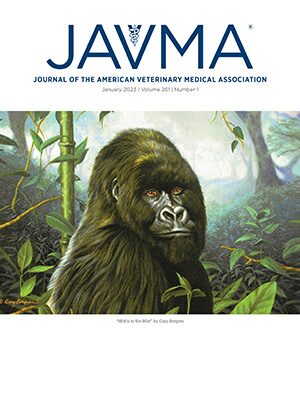- January 5, 2023
- No Comment
- 29 minutes read
Comparison of four endotracheal tube cleaning protocols in … – American Veterinary Medical Association

Advertisement
.avma_container { background: #ddd; width: 100%; padding: 0; margin: 0; opacity: 1; display: flex; } .avma_container div{ display: flex; height: 10px; padding: 0; margin: 0; } .item01 { background: #EBF6F7; width: 100%; }
Colice GL. Technical standards for tracheal tubes. Clin Chest Med. 1991;12(3):433–448. doi:10.1016/S0272–5231(21)00795–4
Centers for Disease Control (CDC). Update on acquired immune deficiency syndrome (AIDS)—United States. MMWR Morb Mortal Wkly Rep. 1982;31(37):507–508, 513–514.
Bednarski RM. Tracheal and nasal intubation. In: Muir WW, Hubbell JAE, eds. Equine Anesthesia: Monitoring and Emergency Therapy. 2nd ed. Elsevier; 2009:277–287.
Juwarkar CS. Cleaning and sterilisation of anaesthetic equipment. Indian J Anaesth. 2013;57(5):541–550. doi:10.4103/0019–5049.120152
Lumley J. Decontamination of anaesthetic equipment and ventilators. Br J Anaesth. 1976;48(1):3–8. doi:10.1093/bja/48.1.3
Rutala WA, Weber DJ, Healthcare Infection Control Practices Advisory Committee. Centers for Disease Control and Prevention: Guidelines for Disinfection and Sterilization in Healthcare Facilities, 2008. Updated May 24, 2019. Accessed August 8, 2021. https://www.cdc.gov/infectioncontrol/guidelines/disinfection/
Stratford BC, Clark RR, Dixson S. The disinfection of the anaesthetic apparatus. Br J Anaesth. 1964;36(8):471–476. doi:10.1093/bja/36.8.471
United States Food and Drug Administration. FDA-Cleared Sterilants and High Level Disinfectants with General Claims for Processing Reusable Medical and Dental Devices. Updated September 25, 2019. Accessed June 27, 2020. https://www.fda.gov/medical-devices/reprocessing-reusable-medical-devices-information-manufacturers/fda-cleared-sterilants-and-high-level-disinfectants-general-claims-processing-reusable-medical-and
Crawford S, Weese JS. Efficacy of endotracheal tube disinfection strategies for elimination of Streptococcus zooepidemicus and Bordetella bronchiseptica. J Am Vet Med Assoc. 2015;247(9):1033–1036. doi:10.2460/javma.247.9.1033
World Health Organization. Decontamination and reprocessing of medical devices for health-care facilities. World Health Organization and Pan American Health Organization; 2016.
Vrioni G, Tsiamis C, Oikonomidis G, Theodoridou K, Kapsimali V, Tsakris A. MALDI-TOF mass spectrometry technology for detecting biomarkers of antimicrobial resistance: current achievements and future perspectives. Ann Transl Med. 2018;6(12):240. doi:10.21037/atm.2018.06.28
Wang X, Jordan K, Mayer L. A phylogenetic perspective on molecular epidemiology. In: Tang YW, Sussman M, Liu D, Poxton I, Schwartzman J, eds. Molecular Medical Microbiology. 2nd ed. Elsevier; 2015:517–536.
Hanson RR. Management of burn injuries in the horse. Vet Clin North Am Equine Pract. 2005;21(1):105–123. doi:10.1016/j.cveq.2004.11.006
Advertisement
To compare the efficacy of 4 cleaning protocols applied to endotracheal tubes (ETTs) collected from anesthetized dogs.
100 ETTs (25 per protocol).
A 10-question survey designed to determine ETT reuse and cleaning practices was distributed via email to a sample of veterinary anesthesiologists. Informed by survey results, 4 ETT cleaning protocols were selected for use in a prospective clinical study. Dogs were intubated with sterile polyvinyl chloride ETTs. At extubation, each ETT was cultured for bacterial growth, randomly assigned to 1 of 4 protocols [water scrub (P1), detergent scrub (P2), detergent scrub and chlorhexidine gluconate (CHG) soak (P3), or detergent scrub and bleach soak (P4)], and cultured again after drying. Bacterial genera were identified using mass spectrometry and 16s rRNA sequencing. Proportions of ETTs exhibiting no post-cleaning growth were compared between protocols using the Fisher exact test with Bonferroni correction.
Half of survey respondents that reused ETTs did not sterilize them before reuse, cleaning methods varied widely, and no reported methods were evidence-based. After use, the number of ETTs exhibiting no post-cleaning bacterial growth were 15/25 (60%), 14/25 (56%), 20/25 (80%), and 17/25 (68%) for protocols P1, P2, P3, and P4, respectively. Pairwise comparisons did not reveal any statistically significant differences between protocols.
In small animal patients, some veterinary anesthesiologists reuse ETTs without sterilization and cleaning protocols vary widely. No differences between the studied protocols were identified. Further research is necessary to identify a safe, efficacious ETT cleaning protocol for use in small animal practice.
To compare the efficacy of 4 cleaning protocols applied to endotracheal tubes (ETTs) collected from anesthetized dogs.
100 ETTs (25 per protocol).
A 10-question survey designed to determine ETT reuse and cleaning practices was distributed via email to a sample of veterinary anesthesiologists. Informed by survey results, 4 ETT cleaning protocols were selected for use in a prospective clinical study. Dogs were intubated with sterile polyvinyl chloride ETTs. At extubation, each ETT was cultured for bacterial growth, randomly assigned to 1 of 4 protocols [water scrub (P1), detergent scrub (P2), detergent scrub and chlorhexidine gluconate (CHG) soak (P3), or detergent scrub and bleach soak (P4)], and cultured again after drying. Bacterial genera were identified using mass spectrometry and 16s rRNA sequencing. Proportions of ETTs exhibiting no post-cleaning growth were compared between protocols using the Fisher exact test with Bonferroni correction.
Half of survey respondents that reused ETTs did not sterilize them before reuse, cleaning methods varied widely, and no reported methods were evidence-based. After use, the number of ETTs exhibiting no post-cleaning bacterial growth were 15/25 (60%), 14/25 (56%), 20/25 (80%), and 17/25 (68%) for protocols P1, P2, P3, and P4, respectively. Pairwise comparisons did not reveal any statistically significant differences between protocols.
In small animal patients, some veterinary anesthesiologists reuse ETTs without sterilization and cleaning protocols vary widely. No differences between the studied protocols were identified. Further research is necessary to identify a safe, efficacious ETT cleaning protocol for use in small animal practice.
Follow JAVMA
Follow AJVR
Follow the AVMA
Subscribe to newsletters
© 2022 American Veterinary Medical Association. All rights reserved.
Powered by KGL PubFactory
Character limit 500/500
Character limit 500/500

